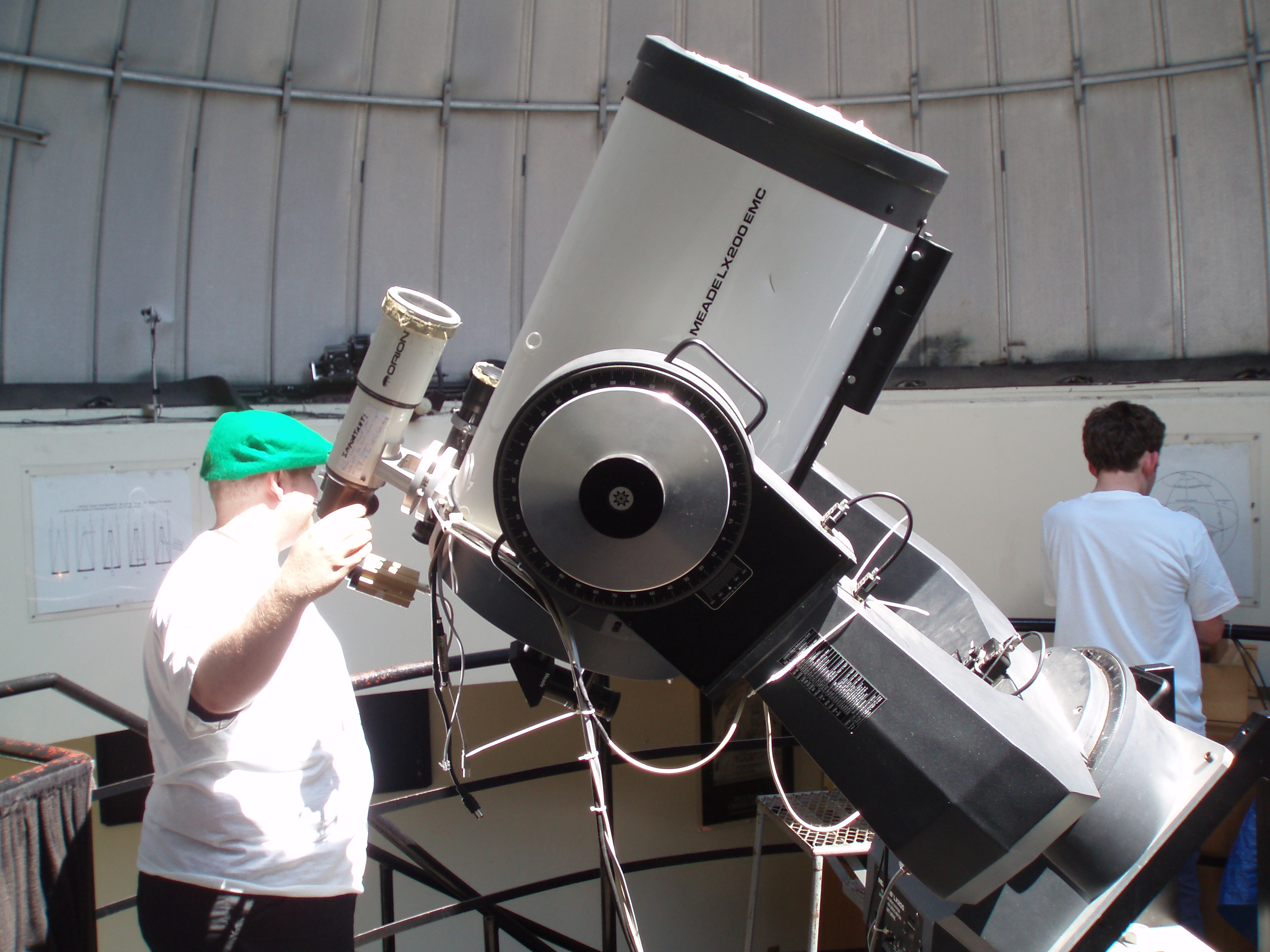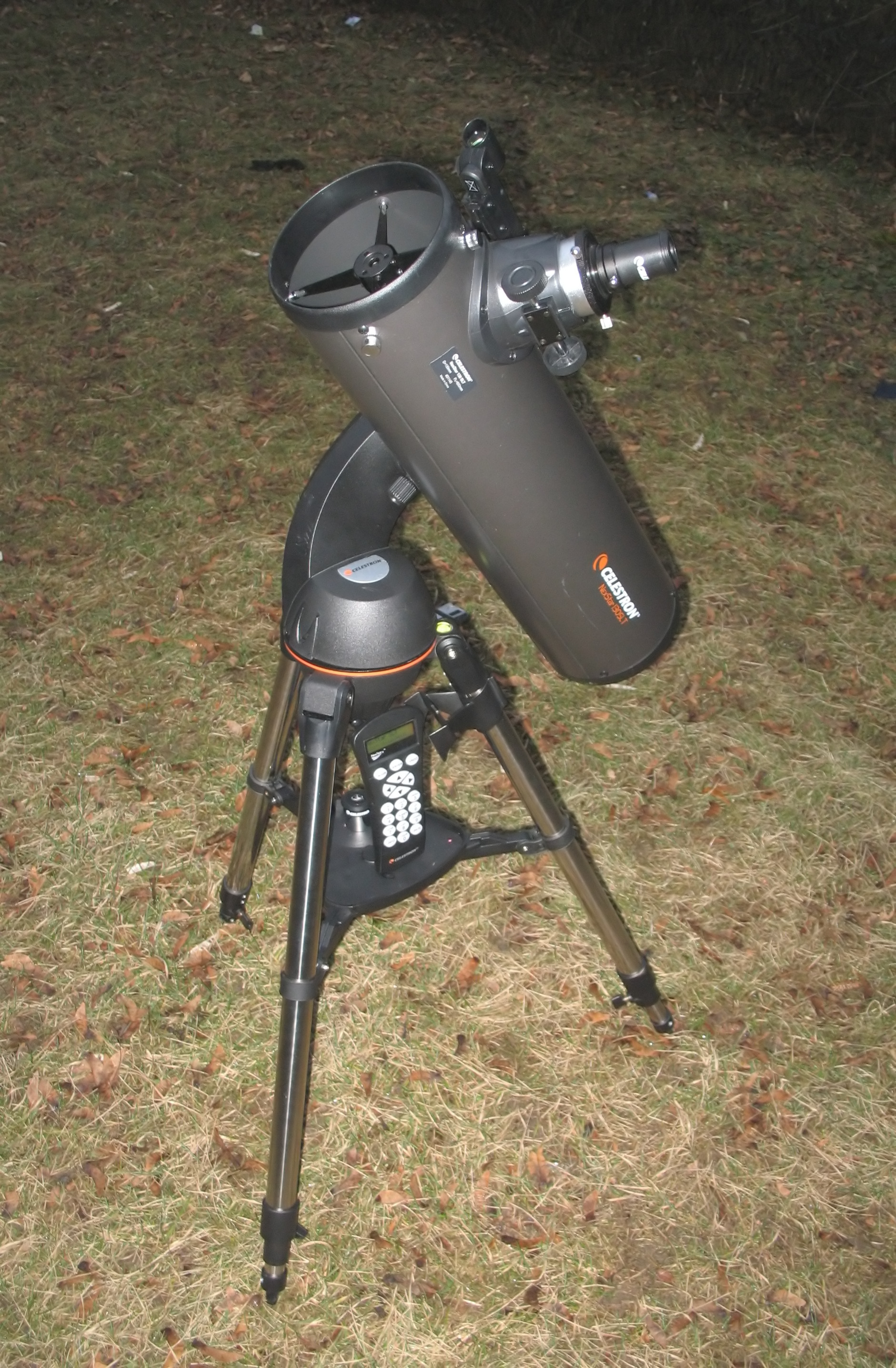|
Meade ETX Telescope
The ETX ("Everybody's Telescope") is a line of smaller aperture telescopes (60mm to 125mm) made by Meade Instruments. Origins The ETX started out as a 90 mm (3-1/2") Maksutov Cassegrain telescope (first produced in 1996) and took advantage of high volume mass production and simplified optical and parts construction to open a new market for a cheap alternative to the very expensive Questar 3-1/2 Maksutov Cassegrain The ETX "line" has been expanded to 105 mm, and 125 mm Maksutov Cassegrains and achromatic refracting telescopes in sizes of 60 mm and 70 mm, but these two models were later replaced by an 80 mm model. The line has come to take advantage of " goto" telescope mount technology, making it very popular with amateur astronomers Amateur astronomy is a hobby where participants enjoy observing or imaging celestial objects in the sky using the unaided eye, binoculars, or telescopes. Even though scientific research may not be their primary g ... [...More Info...] [...Related Items...] OR: [Wikipedia] [Google] [Baidu] |
Optical Telescope
An optical telescope is a telescope that gathers and focuses light mainly from the visible part of the electromagnetic spectrum, to create a magnified image for direct visual inspection, to make a photograph, or to collect data through electronic image sensors. There are three primary types of optical telescope: * Refracting telescopes, which use lenses and less commonly also prisms (dioptrics) * Reflecting telescopes, which use mirrors (catoptrics) * Catadioptric telescopes, which combine lenses and mirrors An optical telescope's ability to resolve small details is directly related to the diameter (or aperture) of its objective (the primary lens or mirror that collects and focuses the light), and its light-gathering power is related to the area of the objective. The larger the objective, the more light the telescope collects and the finer detail it resolves. People use optical telescopes (including monoculars and binoculars) for outdoor activities such as observational as ... [...More Info...] [...Related Items...] OR: [Wikipedia] [Google] [Baidu] |
Meade Instruments
The Meade Instruments (also shortened to Meade) is an American multinational company headquartered in Watsonville, California, that manufactures, imports, and distributes telescopes, binoculars, spotting scopes, microscopes, CCD cameras, and telescope accessories for the consumer market. It is the world's largest manufacturer of telescopes. Besides selling under its "Meade" brand name, the company sells solar telescopes under the brand "Coronado". Origins and history Founded in 1972 by John Diebel, Meade started as a mail order seller of small refracting telescopes and telescope accessories manufactured by the Japan-based Towa Optical Manufacturing Company. Meade started manufacturing its own line of products in 1976, introducing 6" and 8" reflecting telescopes models in 1977. In 1980, the company ventured into the Schmidt-Cassegrain market that up to that time had been dominated by Celestron Corporation. Meade has a long history of litigation with other companies over infri ... [...More Info...] [...Related Items...] OR: [Wikipedia] [Google] [Baidu] |
Mass Production
Mass production, also known as flow production or continuous production, is the production of substantial amounts of standardized products in a constant flow, including and especially on assembly lines. Together with job production and batch production, it is one of the three main production methods. The term ''mass production'' was popularized by a 1926 article in the ''Encyclopædia Britannica'' supplement that was written based on correspondence with Ford Motor Company. ''The New York Times'' used the term in the title of an article that appeared before publication of the ''Britannica'' article. The concepts of mass production are applied to various kinds of products: from fluids and particulates handled in bulk (food, fuel, chemicals and mined minerals), to parts and assemblies of parts (household appliances and automobiles). Some mass production techniques, such as standardized sizes and production lines, predate the Industrial Revolution by many centuries; however, ... [...More Info...] [...Related Items...] OR: [Wikipedia] [Google] [Baidu] |
Questar Corporation
Questar Corporation is a company based in New Hope, Pennsylvania. It manufactures precision optical devices for consumer, industrial, aerospace, and military markets. Its telescopes produced for the consumer market are sold under the brand name "Questar". History Questar was founded in 1950 by Lawrence Braymer, who set up Questar to develop and market Maksutov telescopes and other optical devices for the consumer, industrial, and government customers. The Questar Standard telescope has been in production since 1954. Questars have been associated with many well-known scientists and other personalities; for example, in 1959, Wernher Von Braun purchased a telescope manufactured by the company. Products Questar produces telescopes for consumer, military, police, security, aerospace, and industrial applications. Products sold by Questar include 3.5” (89 mm) and 7” (178 mm) aperture Maksutov Cassegrain astronomical/terrestrial telescopes for the consumer market. For a wh ... [...More Info...] [...Related Items...] OR: [Wikipedia] [Google] [Baidu] |
Achromatic Lens
An achromatic lens or achromat is a lens that is designed to limit the effects of chromatic and spherical aberration. Achromatic lenses are corrected to bring two wavelengths (typically red and blue) into focus on the same plane. The most common type of achromat is the achromatic doublet, which is composed of two individual lenses made from glasses with different amounts of dispersion. Typically, one element is a negative (concave) element made out of flint glass such as F2, which has relatively high dispersion, and the other is a positive (convex) element made of crown glass such as BK7, which has lower dispersion. The lens elements are mounted next to each other, often cemented together, and shaped so that the chromatic aberration of one is counterbalanced by that of the other. In the most common type (shown), the positive power of the crown lens element is not quite equalled by the negative power of the flint lens element. Together they form a weak positive lens that will b ... [...More Info...] [...Related Items...] OR: [Wikipedia] [Google] [Baidu] |
Refracting Telescope
A refracting telescope (also called a refractor) is a type of optical telescope that uses a lens (optics), lens as its objective (optics), objective to form an image (also referred to a dioptrics, dioptric telescope). The refracting telescope design was originally used in spyglasses and astronomy, astronomical telescopes but is also used for long-focus lens, long-focus camera lenses. Although large refracting telescopes were very popular in the second half of the 19th century, for most research purposes, the refracting telescope has been superseded by the reflecting telescope, which allows larger apertures. A refractor's magnification is calculated by dividing the focal length of the objective lens by that of the eyepiece. Refracting telescopes typically have a lens at the front, then a optical train, long tube, then an eyepiece or instrumentation at the rear, where the telescope view comes to focus. Originally, telescopes had an objective of one element, but a century later, tw ... [...More Info...] [...Related Items...] OR: [Wikipedia] [Google] [Baidu] |
GoTo (telescopes)
{{unreferenced, date=February 2014 In amateur astronomy, "GoTo" refers to a type of telescope mount and related software that can automatically point a telescope at astronomical objects that the user selects. Both axes of a GoTo mount are driven by a motor and controlled by a computer. It may be either a microprocessor-based integrated controller or an external personal computer. This differs from the single-axis semi-automated tracking of a traditional clock-drive equatorial mount. The user can command the mount to point the telescope to the celestial coordinates that the user inputs, or to objects in a pre-programmed database including ones from the Messier catalogue, the New General Catalogue, and even major Solar System bodies (the Sun, Moon, and planets). Like a standard equatorial mount, equatorial GoTo mounts can track the night sky by driving the right ascension axis. Since both axes are computer controlled, GoTo technology also allows telescope manufacturers to add eq ... [...More Info...] [...Related Items...] OR: [Wikipedia] [Google] [Baidu] |
Telescope Mount
A telescope mount is a mechanical structure which supports a telescope. Telescope mounts are designed to support the mass of the telescope and allow for accurate pointing of the instrument. Many sorts of mounts have been developed over the years, with the majority of effort being put into systems that can track the motion of the fixed stars as the Earth rotates. Fixed mounts Fixed telescope mounts are entirely fixed in one position, such as Zenith telescopes that point only straight up and the National Radio Astronomy Observatory's Green Bank fixed radio 'horn' built to observe Cassiopeia A. Fixed altitude mounts Fixed-altitude mounts usually have the primary optics fixed at an altitude angle while rotating horizontally (in azimuth). They can cover the whole sky but only observe objects for the short time when that object passes a specific altitude and azimuth. Transit mounts Transit mounts are single axis mounts fixed in azimuth while rotating in altitude, usually orient ... [...More Info...] [...Related Items...] OR: [Wikipedia] [Google] [Baidu] |
Amateur Astronomy
Amateur astronomy is a hobby where participants enjoy observing or imaging celestial objects in the sky using the unaided eye, binoculars, or telescopes. Even though scientific research may not be their primary goal, some amateur astronomers make contributions in doing citizen science, such as by monitoring variable stars, double stars, sunspots, or occultations of stars by the Moon or asteroids, or by discovering transient astronomical events, such as comets, galactic novae or supernovae in other galaxies. Amateur astronomers do not use the field of astronomy as their primary source of income or support, and usually have no professional degree in astrophysics or advanced academic training in the subject. Most amateurs are hobbyists, while others have a high degree of experience in astronomy and may often assist and work alongside professional astronomers. Many astronomers have studied the sky throughout history in an amateur framework; however, since the beginning of the ... [...More Info...] [...Related Items...] OR: [Wikipedia] [Google] [Baidu] |
Meade ETX-70AT
Meade may refer to: Geographic placenames * Meade Glacier, Washington, US * Meade Island, Western Australia * Meade River, Alaska, US Populated places or administrative divisions * Meade, Kansas * Meade, Ohio * Meade County, Kansas * Meade County, Kentucky * Meade County, South Dakota * Meade Township, Huron County, Michigan * Meade Township, Mason County, Michigan Other uses * Meade (surname), people with the surname Meade * Meade Instruments, a company that manufactures telescopes and other astronomy accessories * Meade Senior High School, a high school in Fort Meade, Maryland * Meade Stadium, of the University of Rhode Island in Kingston, Rhode Island See also * Mead (other) * Meades (other) * Meads (other) Meads is a district of Eastbourne, East Sussex, England Meads may also refer to: * MEADS (Medium Extended Air Defense System) * Meads (surname) * Meads, Kentucky, United States * Meads Bay Pond Meads Bay Pond is a wetland in Anguill ... [...More Info...] [...Related Items...] OR: [Wikipedia] [Google] [Baidu] |




